September 12, 2024 · 13 min read
Mitigating Risks in Enterprise Projects through Effective Meeting Management

Shaimaa Badawi
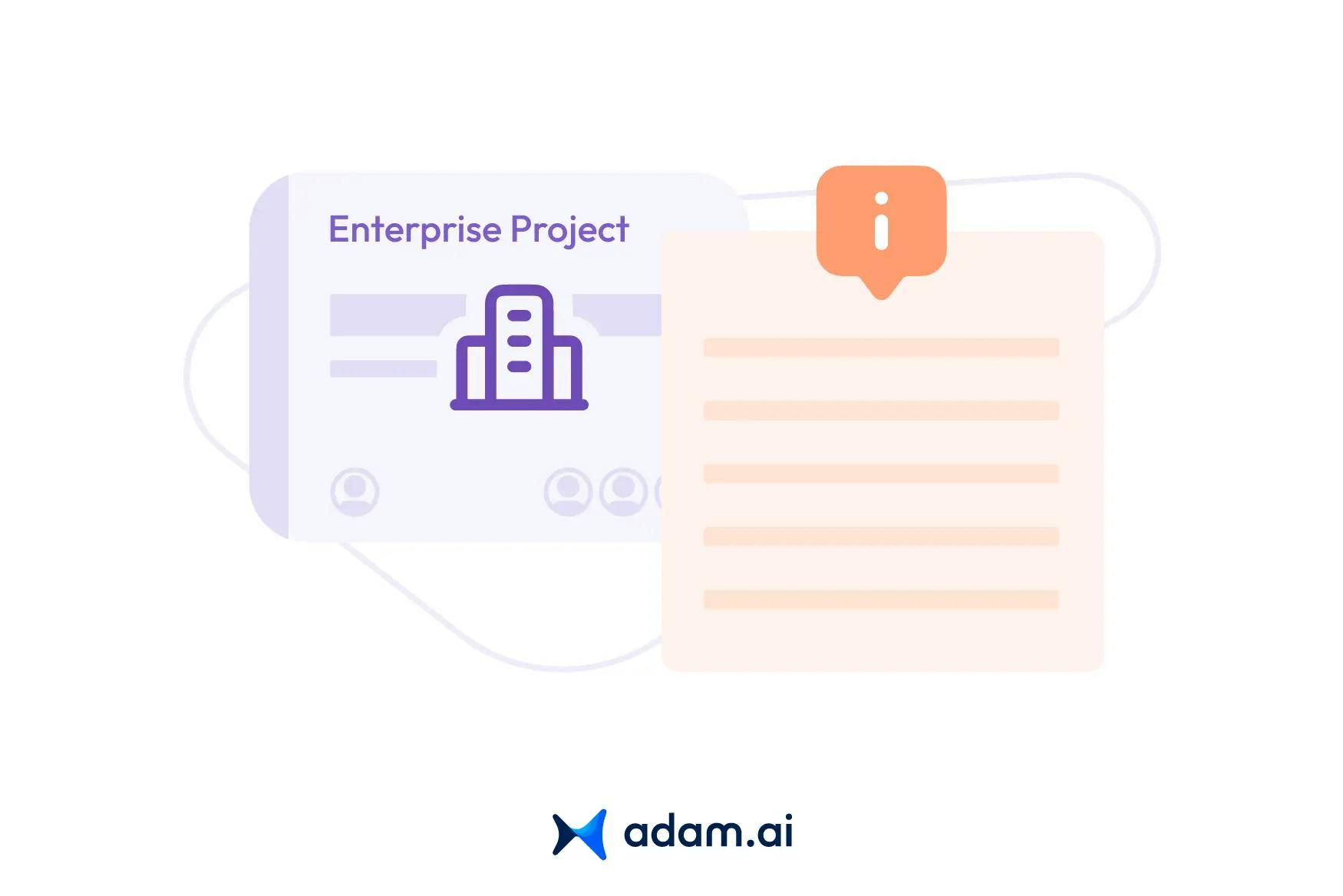
Effective risk management is crucial for achieving success and minimizing potential setbacks. However, poor meeting management can often contribute to overlooked risks, missed deadlines, and miscommunication, all of which can derail a project. In this article, we explore how improving meeting management can play a vital role in mitigating risks in enterprise projects, helping project leaders maintain control over risk, governance, and compliance.
What are the key risks in enterprise projects?
Key risks in enterprise projects typically arise from several areas that can disrupt the successful delivery of a project. These include issues related to scope, budget, timelines, resources, compliance, and more. Here's a breakdown of the most common risks:
- Scope creep: This occurs when a project’s objectives or deliverables expand beyond the original plan, often leading to missed deadlines and budget overruns. It stems from poor requirements gathering or changing client expectations mid-project.
- Budget overruns: Enterprise projects often face financial risks if cost estimations are inaccurate or if there is a lack of proper monitoring of expenses. Poor financial oversight can lead to overspending.
- Resource constraints: Managing a large project requires a skilled workforce, equipment, and other resources. A shortage or misallocation of these resources can significantly impact project progress and quality.
- Compliance and regulatory issues: Enterprises often operate in regulated environments, and failure to comply with industry standards or legal requirements can lead to hefty fines, legal challenges, or operational delays.
- Timeline delays: A major risk in any enterprise project is missing deadlines. Delays can occur due to inefficient processes, unforeseen obstacles, or a lack of proper planning.
- Stakeholder misalignment: If key stakeholders are not aligned on the project’s goals or if communication is weak, it can create confusion and affect decision-making, leading to poor outcomes.
- Technological failures: Issues with the technology stack, software, or hardware being used can disrupt operations, causing delays or requiring unexpected fixes that further complicate the project.
- External risks: Market fluctuations, supplier issues, or geopolitical factors can disrupt the flow of a project, especially if these external elements were not accounted for during planning.
How can poor meeting management increase project risks?
Poor meeting management can significantly increase project risks by creating inefficiencies, miscommunications, and lack of accountability, all of which jeopardize the success of the project. Here’s how it contributes to project risks:
- Ineffective decision-making: Poorly managed meetings often lack clear agendas and structured discussions, leading to delayed or uninformed decisions. This can slow down progress and result in decisions being made without full consideration of risks, increasing the likelihood of poor outcomes.
- Lack of accountability: Without clear action items or follow-ups from meetings, team members may not fully understand their responsibilities, leading to missed deadlines and uncompleted tasks. This can cause critical milestones to be delayed or overlooked, affecting the entire project timeline.
- Missed risks and issues: Poorly managed meetings often fail to address critical risks or potential project roadblocks, as the time may be consumed by irrelevant discussions. This leaves key risks unaddressed, allowing issues to grow until they threaten the project.
- Miscommunications: Meetings that are not well-organized often result in unclear messaging, leading to misunderstandings among team members. This can create confusion about project goals, roles, or timelines, and cause deviations from the planned path.
- Wasted time and resources: Inefficient meetings waste valuable time, leading to decreased productivity. Instead of pushing the project forward, team members are bogged down in unnecessary or unproductive discussions, which diverts resources from more critical tasks.
- Non-compliance and oversight failures: Meetings are a key part of ensuring that projects stay compliant with governance and regulatory standards. Poor management of meetings can result in missed compliance discussions, leading to violations of industry regulations or company policies, increasing the risk of fines or legal challenges.
- Delayed issue resolution: If meetings do not provide clear outcomes or actionable steps, issues that arise during the project remain unresolved. This causes delays in addressing problems, escalating risks, and further complicating the project's trajectory.
Why is risk management essential in enterprise projects?
Risk management is essential in enterprise projects because it helps identify, assess, and mitigate potential issues before they escalate, ensuring that projects are delivered on time, within scope, and on budget. Here's why it plays a critical role in enterprise projects:
1. Prevents cost overruns
By proactively identifying risks, teams can develop strategies to avoid costly disruptions. Without risk management, unforeseen problems can cause budgetary strain, forcing the project to exceed its financial limits.
2. Ensures timely delivery
Unaddressed risks often lead to project delays, causing deadlines to be missed. Risk management helps foresee and mitigate time-related risks, allowing teams to develop contingency plans and keep the project on track.
3. Improves decision-making
A robust risk management process gives project managers and stakeholders a clearer picture of potential issues, allowing them to make informed decisions. It helps prioritize resources and actions based on the level of risk and potential impact on the project.
4. Enhances stakeholder confidence
Having a well-structured risk management strategy in place reassures stakeholders that the project is being managed efficiently and that potential obstacles are being considered. This builds trust and ensures continued stakeholder support throughout the project lifecycle.
5. Reduces scope creep
Projects often face the risk of expanding beyond their original goals, known as scope creep. Risk management helps identify when and how scope changes could occur, allowing teams to address these risks and maintain focus on the project’s original objectives.
6. Ensures compliance and governance
In enterprise projects, compliance with regulations and governance policies is critical. Risk management ensures that potential compliance risks are flagged early, helping the project avoid legal or regulatory issues that could lead to penalties or project failure.
7. Protects reputation
In enterprise-level projects, the company's reputation is at stake. Failure to deliver a project or facing significant issues could harm a company’s brand image. Risk management helps protect the company’s reputation by ensuring issues are anticipated and mitigated before they can negatively impact the project or the organization.
8. Enables agile responses to challenges
Risk management enables teams to respond quickly and effectively to unexpected challenges. By preparing in advance for potential issues, the team can shift gears and implement mitigation strategies, reducing the likelihood of project failure.
How does effective meeting management reduce project risks?
Effective meeting management plays a crucial role in reducing project risks by ensuring that communication is clear, decisions are well-documented, and actions are followed up promptly. Here's how it helps mitigate risks in enterprise projects:
1. Prevents miscommunication
Poor communication is a major source of project risk. Structured meetings with clear agendas and thorough discussions reduce the chance of miscommunication among team members. This ensures that everyone is aligned on project objectives, timelines, and responsibilities.
2. Facilitates risk identification
Regular, well-structured meetings provide a platform for team members to discuss potential risks as they arise. By actively engaging in risk identification, teams can address issues before they escalate, reducing the likelihood of costly delays or project failures.
3. Tracks progress and identifies bottlenecks
Meeting management helps teams stay on top of project progress by regularly reviewing milestones, deadlines, and deliverables. This allows teams to identify bottlenecks early on and take corrective action, preventing risks related to missed deadlines or incomplete tasks.
4. Supports compliance and governance
In regulated industries, effective meeting management ensures that compliance and governance issues are discussed and tracked. This reduces the risk of non-compliance, which could lead to penalties, legal issues, or project failure.
5. Improves stakeholder engagement
Regular, well-managed meetings help keep stakeholders informed and engaged throughout the project lifecycle. This reduces the risk of misalignment between the project team and stakeholders, which can cause dissatisfaction or changes in project direction.
6. Documents decisions and action plans
Meeting minutes provide a record of decisions made, action items assigned, and discussions held. This documentation ensures that the project has a clear reference point for any future disputes or confusion, reducing the risk of misunderstandings or forgotten commitments.
7. Improves decision-making
Meetings that are well-organized ensure that all stakeholders have the necessary information to make informed decisions. This reduces the risk of misinformed or delayed decisions, which can negatively impact project timelines and outcomes.
8. Enhances accountability
By assigning clear action items during meetings and tracking progress, effective meeting management ensures that team members are accountable for their tasks. This minimizes the risk of important tasks being overlooked or delayed, which can cause project setbacks.
What are the best practices for managing risks in enterprise project meetings?
The best practices for managing risks in enterprise project meetings involve proactive planning, clear communication, and systematic follow-up. By integrating these strategies, project teams can minimize risks associated with poor decision-making, lack of accountability, and miscommunication:
1. Set a clear agenda with risk priorities
Creating a well-defined agenda that highlights potential risks and key decisions is critical. Prioritize risk-related discussions, allowing adequate time to address these concerns thoroughly. This ensures the team focuses on identifying, analyzing, and mitigating risks early in the meeting.
2. Involve key stakeholders and decision-makers
Invite all relevant stakeholders, including those directly responsible for risk management, to project meetings. This encourages cross-functional collaboration and ensures that important perspectives are considered, improving risk identification and assessment.
3. Track action items with clear deadlines
Ensure that all decisions and action items related to risk mitigation are documented and assigned clear deadlines. This establishes accountability and keeps the project moving forward by ensuring risks are being addressed promptly and effectively.
4. Foster open communication
Encourage a culture of open communication where team members feel comfortable discussing potential risks. Transparent discussions around challenges and uncertainties can lead to early identification of risks, allowing for quicker resolution.
5. Use data to inform risk discussions
Leverage project data, historical performance metrics, and analytics to guide risk discussions. Data-driven insights can help identify patterns of risk, enabling project managers to make informed decisions about mitigation strategies and resource allocation.
6. Review and update risk mitigation plans regularly
Regularly revisit and update the project’s risk mitigation strategies in meetings. As projects evolve, new risks may emerge while previously identified risks may become less relevant. Ensuring that the risk management plan is always up-to-date helps in keeping the project aligned with its goals.
7. Maintain detailed documentation
Document all meeting decisions, especially those related to risks and mitigation strategies. This documentation can serve as a reference for future meetings, providing transparency and accountability and ensuring that no critical issues are forgotten.
8. Conduct post-meeting follow-up
After each project meeting, follow up with all team members to ensure they are executing their assigned risk-related action items. Following up ensures that tasks are completed and that risk mitigation strategies are actively being implemented.
9. Adopt a proactive approach to risk management
Rather than reacting to risks as they arise, adopt a proactive approach by forecasting potential risks and planning for them in advance. Encourage the team to anticipate challenges and prepare contingency plans for high-probability risks.
10. Utilize meeting management tools for risk tracking
Leverage digital tools like adam.ai to manage meetings more effectively. These tools can track action items, ensure accountability, and provide transparency in real-time, offering a streamlined approach to mitigating risks during meetings.
How can c-level executives use meeting management to oversee risk and compliance?
C-level executives play a crucial role in overseeing risk and compliance, and effective meeting management can provide them with the tools and processes needed to ensure both are maintained throughout a project’s lifecycle. Here's how C-level executives can leverage meeting management to oversee risk and compliance:
1. Centralized oversight of risk discussions
Meeting management platforms allow C-level executives to centralize risk-related discussions, providing a transparent view of the project's risk factors. By utilizing well-structured agendas that prioritize risk assessment and compliance reviews, executives can ensure that potential issues are consistently addressed during meetings.
2. Tracking action items for accountability
Meeting management systems help executives assign and track action items related to risk mitigation and compliance checks. This promotes accountability within teams, as C-level executives can monitor progress on risk-related tasks and ensure that deadlines are met and compliance measures are being followed.
3. Real-time reporting and compliance monitoring
Through meeting management tools, C-level executives can access real-time data and reporting dashboards. This provides visibility into ongoing risk mitigation efforts, project status, and compliance metrics. Real-time insights allow executives to make informed decisions, identify areas that require immediate attention, and ensure the project remains on track regarding regulatory requirements.
4. Facilitating regular risk and compliance reviews
Executives can schedule and manage regular compliance and risk review meetings, ensuring that these critical issues are revisited periodically. Setting up recurring sessions focused on compliance audits and risk evaluation helps keep both topics top of mind and prevents potential lapses in oversight.
5. Enhanced decision documentation for transparency
Proper documentation of meeting decisions, especially those concerning compliance and risk management, is essential for maintaining transparency and accountability. C-level executives can rely on meeting management systems to automatically document discussions, decisions, and actions taken to address risks and regulatory requirements, providing a clear audit trail for future reference.
6. Cross-departmental collaboration for governance
Meeting management tools can foster collaboration across departments by enabling different teams to work together on risk and compliance matters. C-level executives can facilitate cross-functional discussions and ensure that departments such as legal, finance, and operations are aligned on risk management strategies and regulatory adherence.
7. Efficient management of compliance regulations
Executives can utilize meeting management platforms to ensure that compliance with industry regulations and internal policies is integrated into the project process. By monitoring compliance-related discussions and task completions, executives can mitigate the risk of regulatory breaches, which could result in fines or reputational damage.
8. Continuous monitoring of governance and policy implementation
Through structured and consistent meeting management, C-level executives can track the implementation of governance frameworks and policies. This continuous oversight helps ensure that corporate governance standards are being upheld and that all stakeholders are adhering to compliance protocols throughout the project.
Strengthen Your Risk Management Strategy with adam.ai
Effective risk mitigation in enterprise projects requires powerful tools that streamline meeting processes and improve accountability. adam.ai provides C-level executives with the features they need to maintain oversight, manage compliance, and reduce project risks. Here's how:
- Action tracking for risk accountability
adam.ai enables you to assign, track, and monitor action items across multiple teams, ensuring that risk mitigation tasks are completed on time. Executives can easily view progress on key risk-related actions, making sure that nothing falls through the cracks.
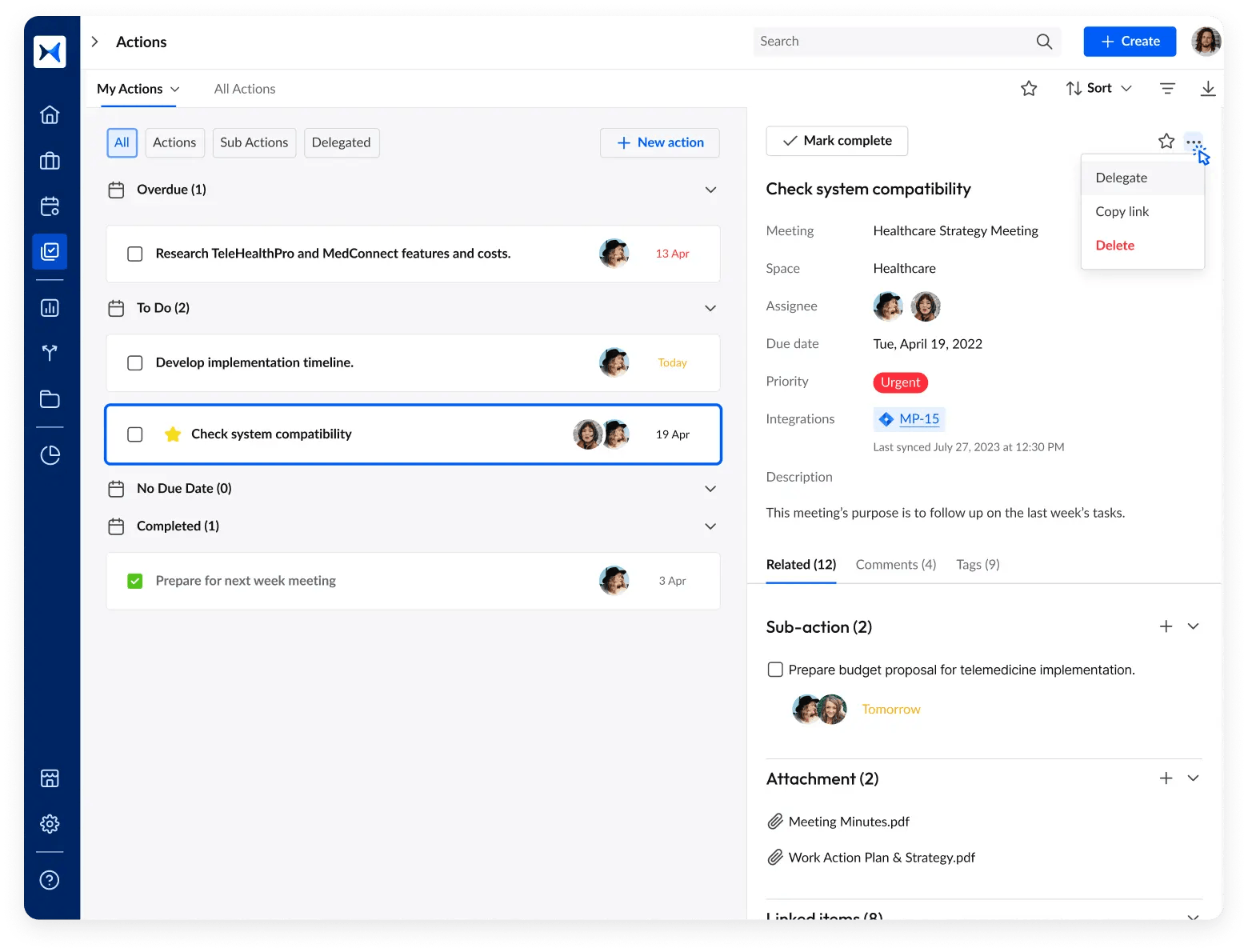
- Automated meeting minutes
Capturing and documenting critical decisions related to risk management is effortless with adam.ai. The platform automatically generates meeting minutes, detailing key decisions and actions, which creates a transparent record of how risks are being addressed.
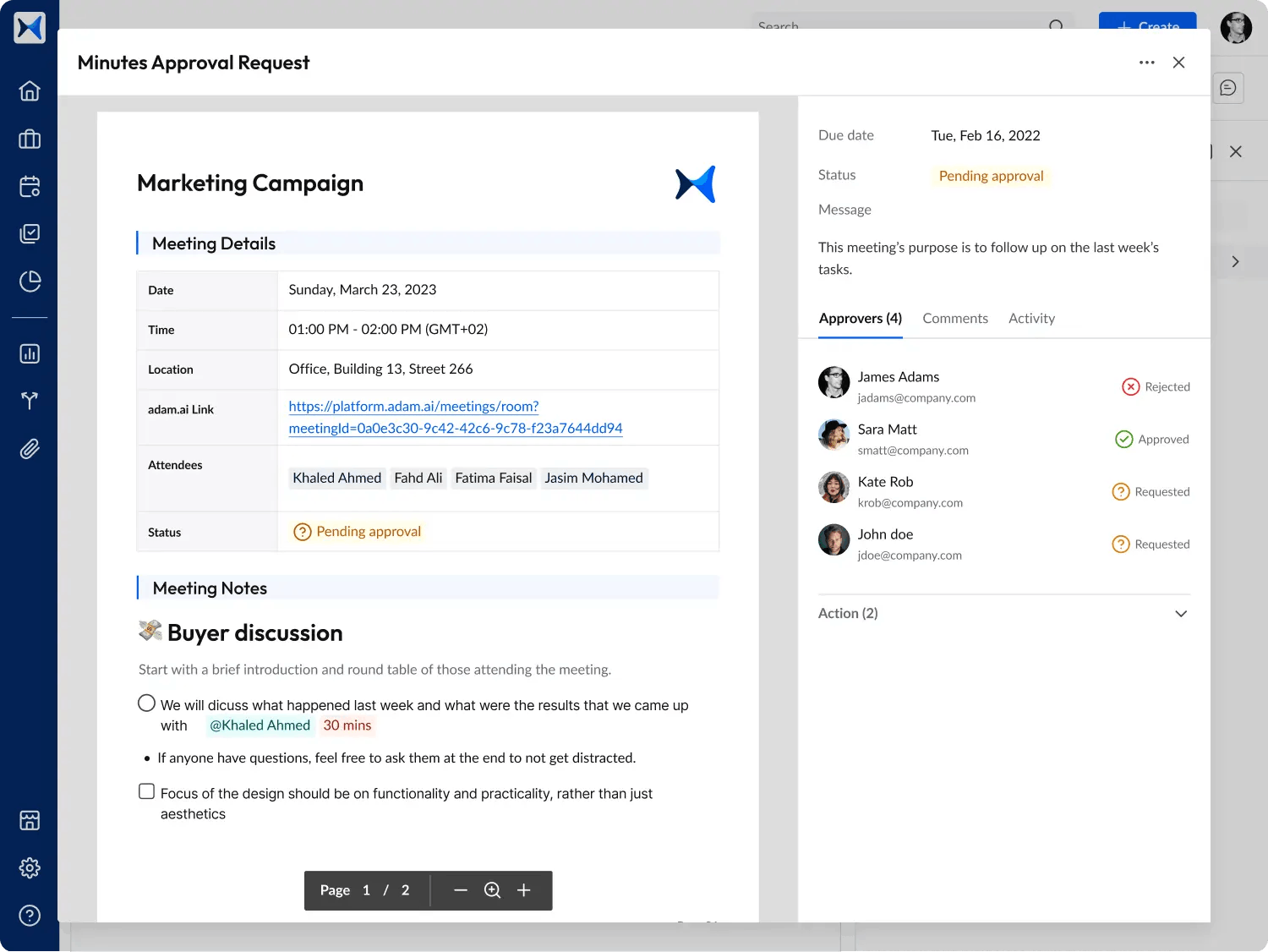
- Compliance monitoring through structured agendas
Executives can create detailed, compliance-focused meeting agendas that ensure discussions stay on track. The ability to organize meetings around key compliance and governance topics ensures that all regulations are adhered to and that any potential issues are highlighted early.
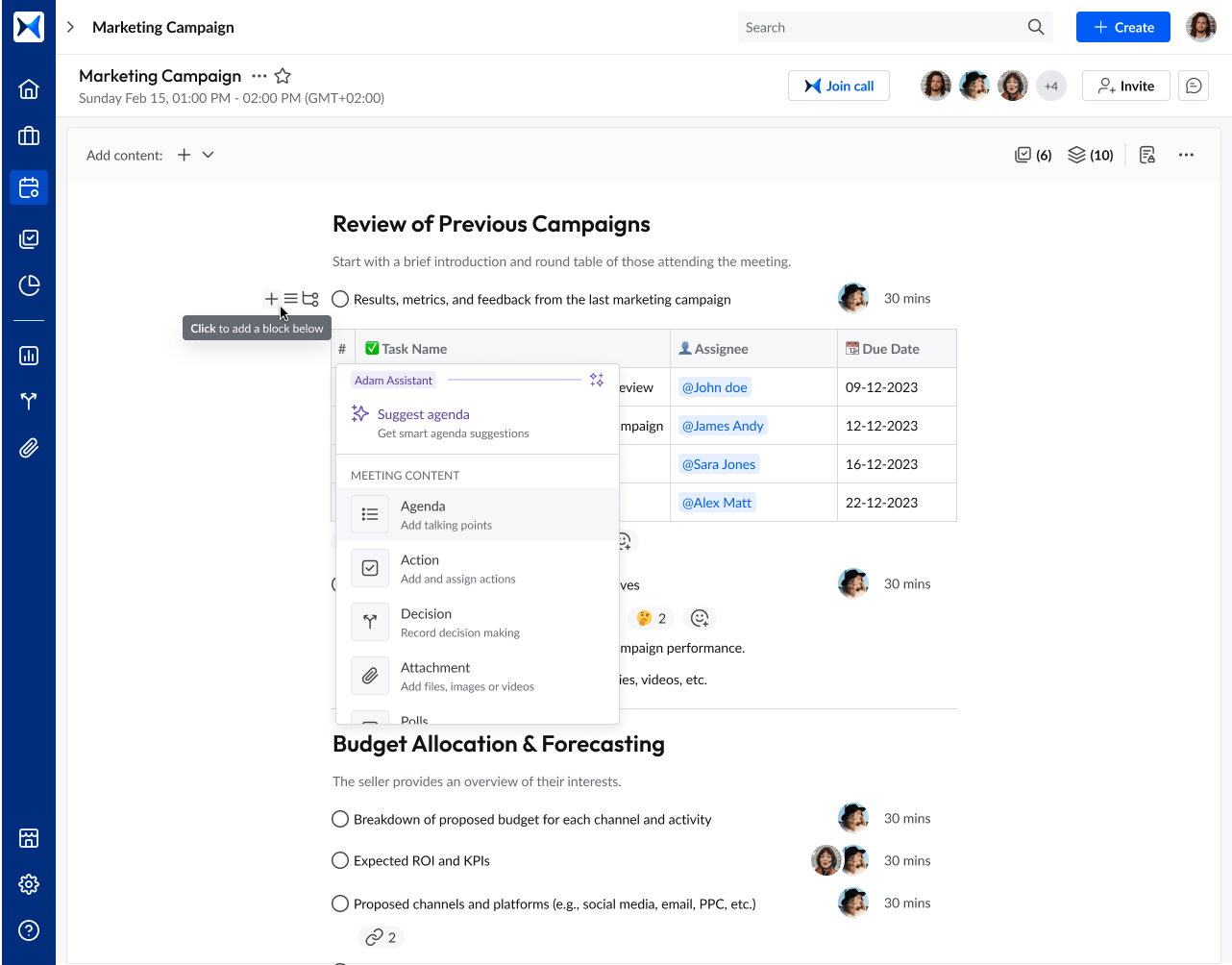
- Real-time reporting and analytics
adam.ai’s analytics dashboard provides real-time insights into meeting outcomes, tracking risk management progress and compliance adherence. These data-driven insights help executives make informed decisions to address risks promptly and keep the project moving forward.
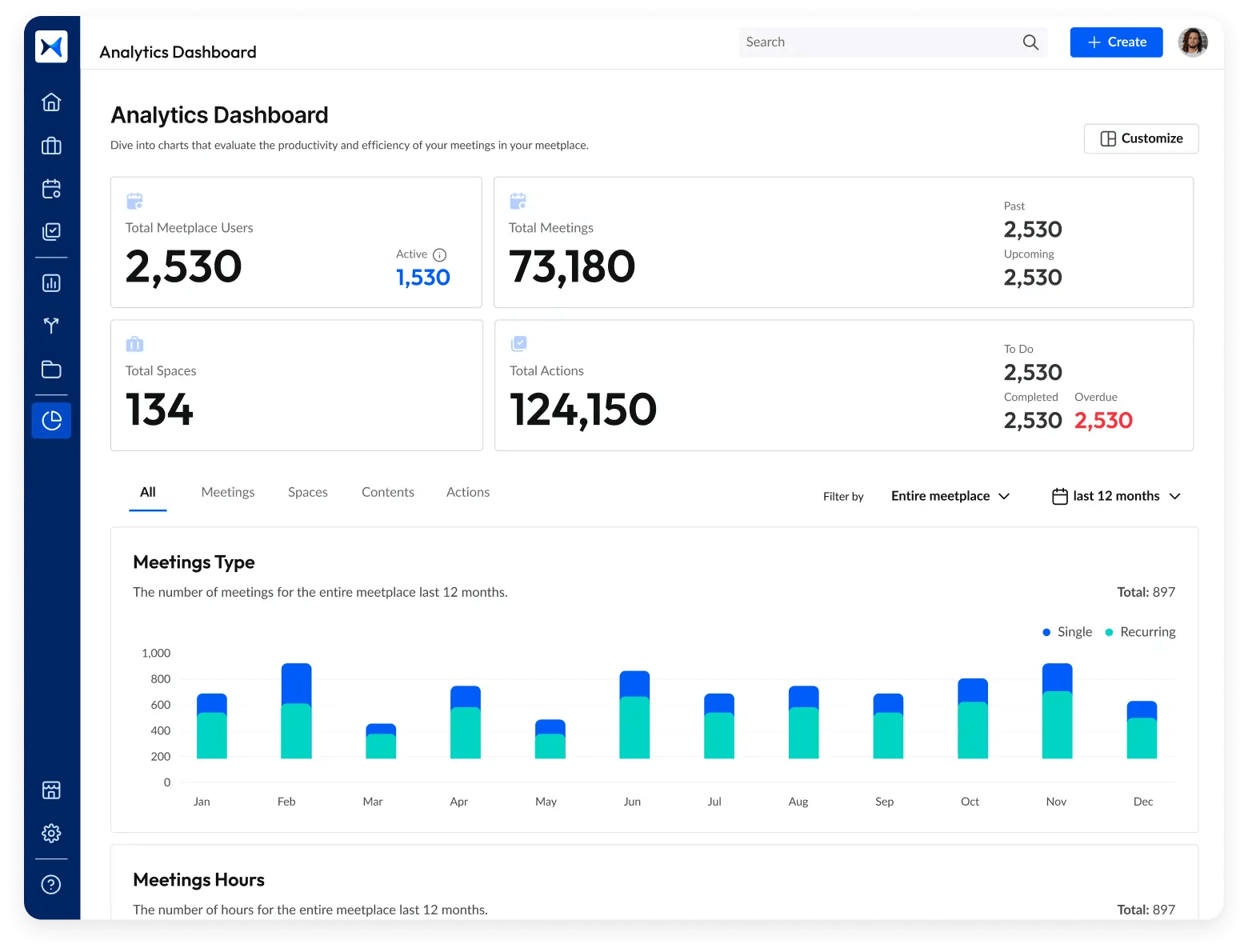
- Seamless cross-departmental collaboration
By organizing meetings across departments within the platform, adam.ai fosters collaboration between teams such as finance, legal, and operations. This allows C-level executives to ensure that risk and compliance concerns are communicated effectively across the enterprise.
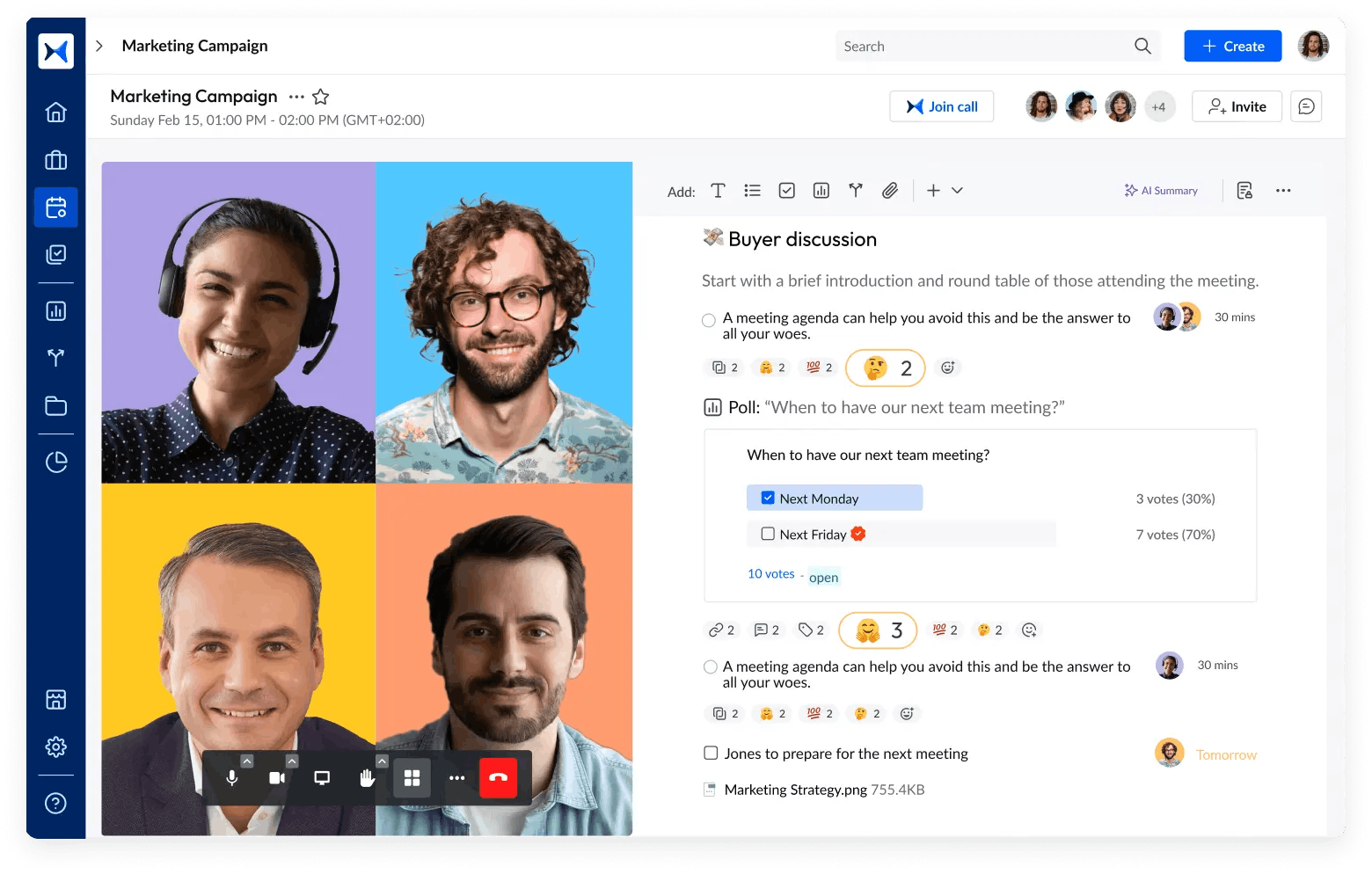
- Multi-space project organization
For enterprises managing multiple high-risk projects, adam.ai provides multi-space functionality to compartmentalize each project’s risk management efforts. This ensures clear visibility and organization of risk factors across complex project portfolios.
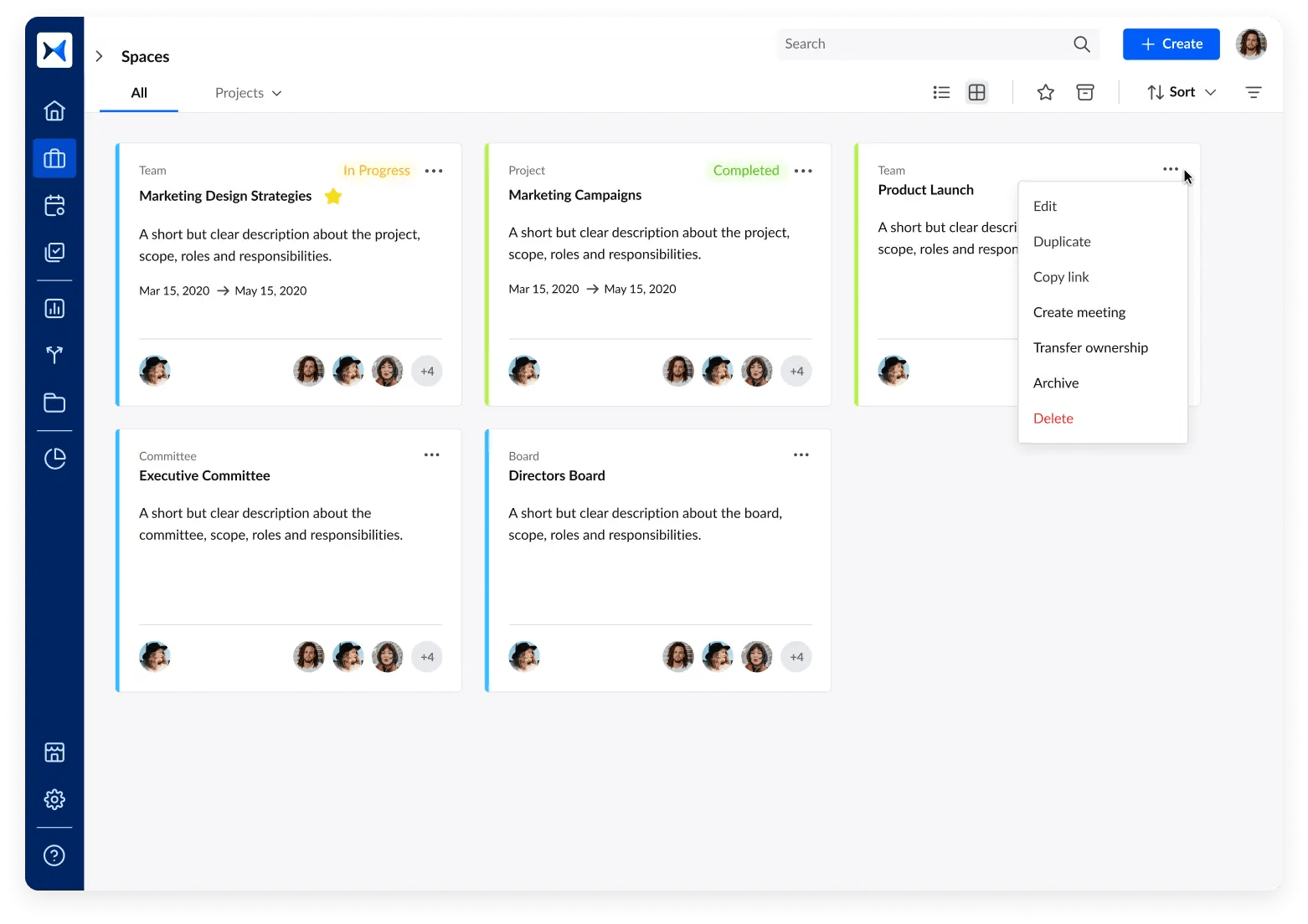
- Voting and decision-making tools
When critical risk decisions need to be made, adam.ai’s voting and polling features help executives gather input from key stakeholders quickly and transparently. This streamlines the decision-making process while ensuring that all voices are heard, reducing the risk of errors.
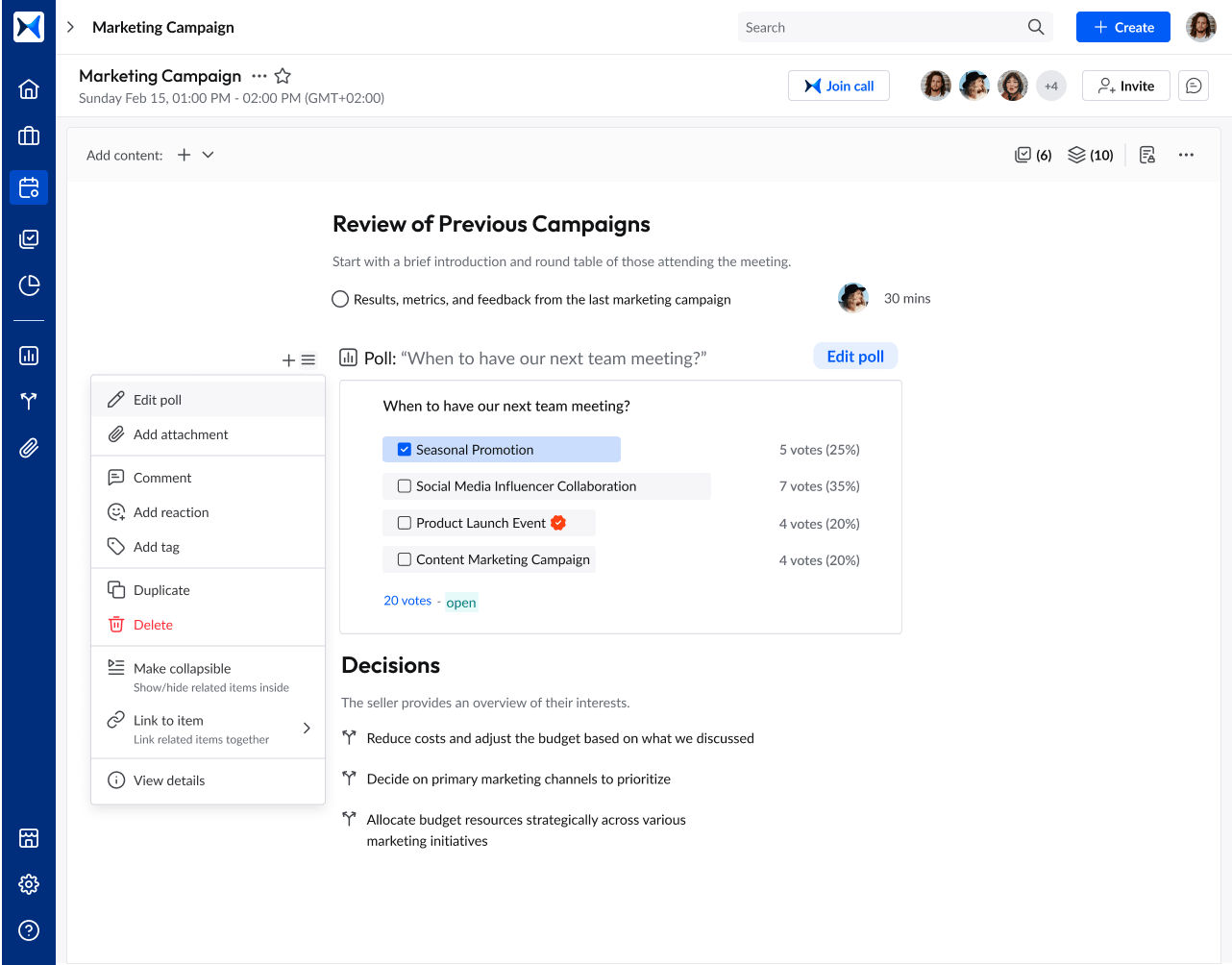
Transform how you conduct critical meetings—From meticulous preparation to effective execution and insightful follow-up, adam.ai integrates comprehensive analytics, full customization, and intuitive interfaces with powerful meeting management tools.
Easy onboarding. Enterprise-grade security. 24/7 dedicated support.
The bottom line
Mitigating risks in enterprise projects requires more than just identifying potential problems; it requires actionable steps, accountability, and transparent communication. Modern tools, like adam.ai, offer the features needed to streamline these efforts, enabling leaders to effectively oversee risk and compliance with confidence.
And while there may be multiple solutions available, here is why adam.ai is the meeting management software platform you can trust:
- adam.ai is one of Atlassian Ventures' portfolio companies.
- In the meeting management software category on G2, adam.ai has been ranked a leader and a high performer for successive quarters in the past years.
- adam.ai has been included in the Forrester Report in the AI-enabled meeting technology landscape.
- adam.ai is trusted and used by powerful teams and organizations worldwide for all types of critical meetings, like board, committee, project management, and business development meetings.
- And most importantly, adam.ai integrates with your existing workflow, is SOC2 compliant, provides dedicated support and success, and has a free trial option.
Subscribe to adam.ai blog
Stay ahead with the latest insights—get our newest blog posts, tips, and updates sent straight to your inbox.